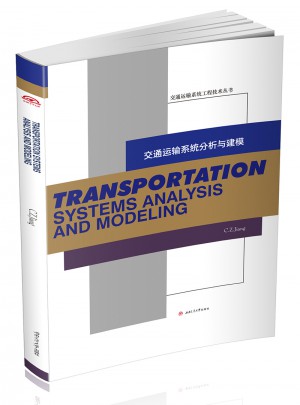
交通運(yùn)輸系統(tǒng)分析與建模
- 所屬分類:圖書 >工業(yè)技術(shù)>汽車與交通運(yùn)輸>綜合運(yùn)輸
- 作者:[蔣朝哲]
- 產(chǎn)品參數(shù):
- 叢書名:--
- 國際刊號(hào):9787564346225
- 出版社:西南交通大學(xué)出版社
- 出版時(shí)間:2016-11
- 印刷時(shí)間:2016-11-01
- 版次:1
- 開本:16開
- 頁數(shù):--
- 紙張:膠版紙
- 包裝:平裝-膠訂
- 套裝:否

本書首先重新定義了交通系統(tǒng),針對(duì)交通運(yùn)輸供給系統(tǒng)進(jìn)行分析,特別是基于運(yùn)輸成本和交通流量的關(guān)系,通過交通流理論、效用函數(shù)理論等對(duì)交通運(yùn)輸系統(tǒng)用戶行為以及客運(yùn)與貨運(yùn)規(guī)律進(jìn)行數(shù)學(xué)建模,其中包括交通運(yùn)輸網(wǎng)絡(luò)靜態(tài)和動(dòng)態(tài)均衡模型,后介紹如何通過數(shù)據(jù)對(duì)已經(jīng)建立的模型校正。本書適合相關(guān)專業(yè)本科、研究生及相關(guān)的研究人員參考。
蔣朝哲: 西南交通大學(xué)交通運(yùn)輸工程博士后,副教授;加拿大滑鐵盧大學(xué)土木與環(huán)境工程系博士后,副研究員。主要研究方向包括系統(tǒng)決策理論與方法,交通運(yùn)輸系統(tǒng)工程,大數(shù)據(jù)在交通中的應(yīng)用,城市交通排放(PM2.5)等領(lǐng)域。出版專著教材10余部,發(fā)表學(xué)術(shù)論文60余篇,其中被SCI,EI,ISTP收錄近20余篇,主持主研國家自然科學(xué)基金、國家社科基金等國家省部級(jí)以及加拿大國家和省部級(jí)課題20余項(xiàng)。
CONTENTS
Part A Transportation Systems Analysis and Modeling Process 1
Chapter 1 Introduction to Transportation Systems 1
1.1 Definitions 1
1.1.1 Preliminary Concepts of Transportation Systems 1
1.1.2 Components of Transportation Systems 2
1.1.3 Relationship Between Transportation Systems and Activity Systems 5
1.2 Transportation System Identification 6
1.2.1 Relevant Spatial Dimensions 6
1.2.2 Relevant Temporal Dimensions 10
1.2.3 Relevant Components of Travel Demand 14
1.3 Macroscopic Measures of a Traffic Stream 17
1.3.1 Fundamental Parameters of Traffic Flow 17
1.3.2 Derived Characteristics 21
1.3.3 Time-space diagram 23
1.3.4 Fundamental Relationship 25
Chapter 2 Transportation Systems Analysis Framework 29
2.1 Background of the Current Transportation Environment Changing 29
2.2 Basic Premise of a Transportation System 29
2.3 Interrelationship of Transportation and Activity System 30
2.4 Intervening Transportation/Activity/Flow (TAF) System 31
2.5 Prediction of Transportation Flows 33
Chapter 3 Transportation Systems Mathematical Modeling Fundamentals 35
3.1 The Function of Mathematical Modeling 35
3.2 General Assumption for Transportation Systems Modeling 36
3.2.1 Physical and Functional Delineation Assumption 36
3.2.2 Spatial Discretization Assumption(Zoning) 36
3.2.3 Identification of Relevant Transportation Services 36
3.2.4 Identification of Relevant Model Periods 36
3.2.5 Withinperiod Variability Assumption 36
3.3 Mathematical Models Family Structure for Transportation System 37
3.4 Supply Models Simulating Transportation Systems 37
3.5 Demand Models Simulating Transportation Systems and Activity 38
3.6 Network Demand-Supply Interaction Modeling 38
Part B Transportation Supply Analysis and Modeling 42
Chapter 4 Macroscopic Traffic Stream Modeling 42
4.1 Introduction 42
4.2 Greenshield’s Macroscopic Stream Model 43
4.3 Calibration of Greenshield’s Model 45
4.4 Other Macroscopic Stream Models 46
4.4.1 Greenberg’s Logarithmic Model 46
4.4.2 Underwood’s exponential model 46
4.4.3 Pipes’ Generalized Model 47
4.4.4 Multi-Regime Models 47
4.5 Shock Waves 48
4.6 Macroscopic Flow Models 50
Chapter 5 Microscopic Traffic Flow Modeling 52
5.1 Introduction 52
5.2 Notation for Car Following Modeling 52
5.3 Car Following Models 53
5.3.1 Pipe’s Model 53
5.3.2 Forbes’ Model 54
5.3.3 General Motors’ Model 54
5.3.4 Optimal Velocity Model 54
5.4 General Motor’s Car Following Model 55
5.4.1 Basic Philosophy 55
5.4.2 Follow-the-Leader Model 55
5.5 Simulation Models 57
5.5.1 Applications of Simulation 57
5.5.2 Need for Simulation Models 58
5.5.3 Classification of Simulation Model 58
Chapter 6 Trip Generation Analysis and Modeling 59
6.1 Basic concepts 59
6.2 Trip Generation Analysis Methods 59
6.3 Regression Analysis Method 62
6.4 Cross-Classification Method 68
6.5 Model Stability over Time 73
6.6 Summary 74
Part C Trip-based Demand Analysis and Modeling 77
Chapter 7 Trip Distribution Analysis and Modeling 77
7.1 Problem Definition 77
7.2 Gravity Models 80
7.3 Calibration of Doubly Constrained Gravity Models 87
7.4 Summary 95
Chapter 8 Modal Split Analysis and Modeling 98
8.1 Introduction 98
8.2 Factors Influencing Mode Choices 99
8.3 Aggregate Mode Choice Models 99
8.4 Disaggregate Choice Models 103
8.4.1 Modeling Framework: the Utility Theory 104
8.4.2 Logit Model 109
8.4.3 Calibration of Logit Models 112
8.5 Disaggregate Choice Models vs Traditional Aggregate Models 124
8.6 Summary 126
Chapter 9 Network Traffic Assignment Analysis and Modeling 129
9.1 Requirements for Network Traffic Assignment 129
9.2 Road Network Models 130
9.3 Shortest Path Algorithms 133
9.4 Route Choice Behaviour Model 139
9.5 Traffic Assignment Methods 141
9.6 Summary 149
References 152
Appendix A Linear Regression Analysis 155
Appendix B Calibrating Logit Models Using Logistic Regression in SPSS 174